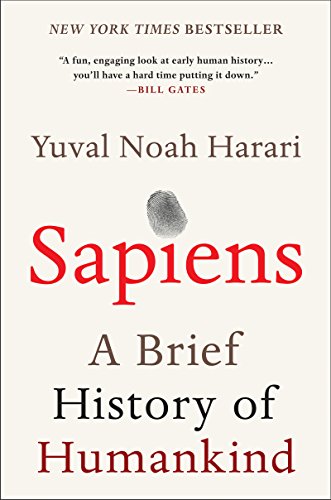

This article is an excerpt from the Shortform summary of "Sapiens: A Brief History of Humankind" by Yuval Noah Harari. Shortform has the world's best summaries of books you should be reading.
Like this article? Sign up for a free trial here .
What is the social constructionist theory? How does the fact that our reality is socially and culturally constructed influence our beliefs and behaviors?
The social constructionist theory is the theory that our societies function on shared assumptions and collective “myths.” These assumptions and beliefs aren’t natural–rather, they are created by society and culture itself.
We’ll cover the origin of social constructs and how social constructionist theory explains many of your beliefs about what is “natural” or common sense, and what isn’t.
Social Constructionist Theory and the Ability to Create Fictions
A benefit of the Sapiens’ language was how it was used to create fictions, also known as “social constructs” or “imagined realities.” These were the first social constructs.
Being able to communicate information about things that don’t exist doesn’t seem like an advantage. But Sapiens seem to be the only animals who have this ability to discuss things that don’t have a physical presence in the world, like money, human rights, corporations, and God.
For instance, you can’t convince a monkey to give you its banana on the argument that if it does, it will get unlimited bananas when it dies and goes to heaven. Your negotiations with monkeys are limited because you can only promise rewards that exist materially in this world. Monkeys can’t create imagined realities like heaven.
Collective Fictions
In and of itself, imagining things that don’t exist isn’t an asset—you won’t aid your chances of survival if you go into the forest looking for ghosts rather than berries and deer.
What’s important about the ability to create fictions is the ability to create collective fictions, fictions everyone believes. These collective myths allow people who’ve never met and otherwise would have nothing in common to cooperate under shared assumptions and goals. Collective fictions are another name for social constructions of reality.
Collective fictions aren’t the same as lies. These aren’t lies because everyone collectively believes them. For example, members of the UN weren’t lying when they insisted that Libya’s government respect the rights of its citizens, even though Libya, human rights, and the UN itself are all imaginary realities, or social constructs. The borders that separate Libya from other countries are man-made, not physical features of the landscape; human rights is a concept many of us believe in, but rights don’t exist outside our collective imagination; and, like Libya, the UN is a social construct, an organization that has no physical existence.
According to the social constructionist theory, while humans lived without these social constructs for millennia, today, imaginary realities in some cases matter more than objective realities. For instance, the survival of actual entities like rain forests and endangered river dolphins depends on the charity of imaginary entities like the United States and non-profit organizations.
Let’s look at a modern example of how we unquestioningly accept social constructs and treat them as real entities.
Social Construction of Reality, Example #1: Peugeot
Does the carmaker Peugeot exist?
It must. The corporation employs 200,000 people, makes 1.5 million cars a year, and earns about 55 billion euros annually.
- But in what way does Peugeot exist? Can you locate it in physical reality? The company isn’t its cars. The cars could all go away and the company would still exist.
- The company isn’t its employees, its factories, or its machinery. A natural disaster could wipe out every factory and every employee, and the company would still exist and be able to get a loan, build new factories, and hire new workers.
- The company is not its founder (who’s dead) or its managers and shareholders, who could be dismissed today without threatening the company’s existence.
So how can it exist? Peugeot, as with other corporations, has no existence in the physical world. It’s an idea, a collective myth, a social construct, we all agree to believe in. This myth is so powerful that this imaginary entity can buy property, pay taxes, open a bank account, and be bound by laws.
We grant these legal fictions, called limited liability companies, the same rights as people (the concept of “rights” is a fiction, too). We treat LLCs like flesh-and-blood people.
The Birth of Limited Liability Companies
The Problem
It wasn’t always the case that a business owner could divorce himself from his business. In the 13th century, before the (imaginary) existence of LLCs, if you owned a business, you were personally liable for everything that happened with that business.
So if your product broke, your customer could sue you personally. If you borrowed money and the business flopped, you had to pay back the debt out of pocket. If you couldn’t, you might have to sell your personal property or sell your children into servitude.
When you are your business and your business is you, starting a business is a scary prospect. People didn’t want to take the financial risk, and this impeded entrepreneurship.
The Solution
The solution to this problem was limited liability companies. The company became an entity independent of its founder, manager, or any other person or physical entity.
We’re so used to these corporations that we forget they’re imaginary, existing only in our minds and invented only to shield their founders from too much personal responsibility.
Back to Peugeot
Often, the problem with imaginary things is that it’s hard to get others to believe them (their power comes only with collective belief in them). But in France in the 1890s, if you got a lawyer to go through the ritual required of the French legal code (another fiction), involving writing down the correct words on a fancy sheet of paper and signing it, you could create a totally imaginary company that millions of French citizens would tacitly agree to believe.
French law validated the existence of Peugeot. In other words, one imaginary entity legitimized another imaginary entity. Peugeot is a social or cultural construction.
Social Constructs and the Fiction of the Political Order
People evolved to cooperate in small groups. As their way of life changed rapidly, there was no time for Sapiens to evolve the skills of mass cooperation. As groups of people got bigger, they needed some kind of organizing structure, a way to help people work together to divide land, settle disputes, and keep the peace. Organizing so many people involved creating myths that served as the links between previously distinct bands of people. This was the foundation of cooperation.
According to the social constructionist theory, fictions can foster cooperation among nations and empires. We’ll look at the Code of Hammurabi and the Declaration of Independence together to demonstrate how these seemingly dissimilar documents actually function very similarly.
Fictions, or social constructs, can be useful. We like to think that political orders are founded on truths, but in reality, political orders are unable to function without relying on fictions.
Social Construction of Reality, Example #2: The Code of Hammurabi
The Code of Hammurabi
In 1776 BC, the Babylonian Empire was the biggest in the world, with over a million subjects. King Hammurabi established a code that presented his power and legal system as mandated by the gods. The code emphasized hierarchy, breaking the population into “superior people,” commoners, and slaves. Your worth was established based on your class and gender.
The idea was that if everyone accepted this code, the empire’s million subjects could cooperate with each other. And it worked. People believed the myth that the gods dictated these laws, rights, and differing human worths, and the Code of Hammurabi is still known today.
Social Construction of Reality, Example #3: The American Declaration of Independence
It’s easy to think of the Code of Hammurabi as a myth. It may not be as easy to think of our own country’s foundational document as a myth.
Similar to Hammurabi’s assertion that his code came from the gods, Thomas Jefferson justifies the rights proclaimed in the Declaration of Independence by writing that they are “endowed by [men’s] Creator.” Both have a divine source. Also like the Code of Hammurabi, the Declaration of Independence was written as a way to unify disparate groups of people.
Unlike the Code, the Declaration is based not on hierarchy but on equality. Who’s right? Neither. The concepts of rights and equality are just as much myths as the concepts of hierarchy and of value based on class and gender. They exist only in the mind.
In order for the phrase “all Men are created equal” to be true, we’d have to find that sentiment in the physical world. But there’s no sense in which we are equal in objective reality. People have different genes, are influenced by different environments, develop different personalities, and have different chances of success and survival. The evolution of our species depends on our differences, our genetic mutations.
There’s also no objective existence of “rights.” For example, birds don’t fly because they have the right to fly. They fly because they have wings. Likewise, “liberty” is a concept humans invented. You can’t measure it and it doesn’t exist outside our minds.
None of this means that the Declaration of Independence is a lie or worthless. It has helped create a stable, cooperative society. In fact, collective myths are the only way to organize large groups effectively.
The Factors That Keep Us From Realizing Our Order is Imagined
Why are social constructs invisible to us?
Factor #1: The imagined order is woven into objective, material reality.
According to the social constructionist theory, we live the principles of our social constructs in daily life. It even affects our architecture. Compare how architecture differs in individualistic societies vs. collectivist societies.
Individualism Architecture
In the West, we believe that we’re all individuals, unique in the world, and that only we know our true worth. When you’re a kid in school and your classmates make fun of you, your teachers tell you to just ignore them. They don’t define your worth. Only you know your worth.
Our architecture expresses this belief in individualism. Houses consist of many rooms so that each child can have his or her own space. These rooms have doors, locks, and are often decorated by the child, with posters and colors that the child feels represent her. Parents often have to ask permission to enter the child’s room. If you have your own space, you can’t help but grow up feeling like an autonomous individual, believing your worth is defined and expressed by you.
Architecture is part of the material, “real” world. But it reinforces an imagined principle.
Collectivism Architecture
Medieval communities, on the other hand, didn’t believe in the myth of individualism. In their imagined order, your worth was determined by those outside of you, by the gossip about you and your place in the social hierarchy. You had to defend your good name at all times, at all costs. Nothing mattered more.
Medieval architecture reflected this myth. Castles contained few, if any, private rooms. Even the children of noblemen slept in a large hall with the other children. Everyone was on display and accountable. If you never have privacy and are in constant contact with others, you can’t help but grow up believing that your worth is determined by the people around you.
Again, something in the real world (architecture) reinforced a principle of the imagined order (collectivism).
Factor #2: Our wants are shaped by the imagined order.
Both Romantic myths from the 19th century and consumerist myths from the 20th century influence what we desire. Even when we think we’re making our own, personal decisions by following our hearts, what our heart wants is probably influenced by these myths. Further, the whole idea that you should “follow your heart” comes from the myths of the Romantic period.
Take the tourism industry, for example. We all want to go on vacation. We think this is a natural thing to want to do. It’s not. A chimpanzee wouldn’t think of using his hard-earned status to take a trip to another chimpanzee’s territory.
Our ancestors wouldn’t have done this, either. While today, a millionaire might take his wife on a trip to Paris to help them weather a rough patch in their marriage, an ancient Egyptian might have built his wife the lavish tomb she coveted.
Traveling is not a natural, biological urge. So why do we want to go so badly?
- Romanticism: This imagined order says that to have our most fulfilling lives, we need to try new things, go to new places, and have new experiences.
- Consumerism: This imagined order says that to have our most fulfilling lives, we need to consume products and services.
According to the social constructionist theory, Romanticism and Consumerism find their marriage in the tourism industry, which sells you experiences on the assumption that they will enrich your life. These are social constructions of reality.
Factor #3: The imagined order doesn’t just exist inside our heads—it’s collective.
It’s hard to realize that the organizing principles of your life are just imaginary when everyone else takes them for granted as well. When everyone else believes something, and it’s something embedded in your culture since you were born, it feels natural for you to believe it too.
Further, it’s hard to change the socially-constructed imagined order when it exists in the collective mind, not just yours. When something exists in the collective imagination of a population, it’s called inter-subjective. Something that is inter-subjective depends on a group believing in it. If one individual stops believing in it, the inter-subjective item is still there. So one person can’t change a collective imagined order on her own. You not only have to convince the people around you that it’s imaginary, but you have to replace it with another imagined order, one even more powerful, because we can’t function without them.
According to the social constructionist theory, many things we take for granted are actually socially or culturally constructed.
———End of Preview———

Like what you just read? Read the rest of the world's best summary of "Sapiens" at Shortform . Learn the book's critical concepts in 20 minutes or less .
Here's what you'll find in our full Sapiens summary :
- How Sapiens outlived and outlasted the 8+ other human-like species on Earth
- The 3 critical revolutions in human existence that led to our domination of the planet
- How much of what powers our world today is really just a shared mass delusion
- What the future of humanity might look like






